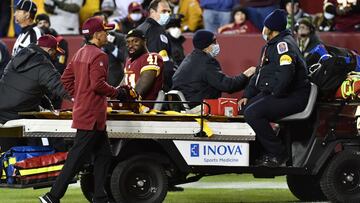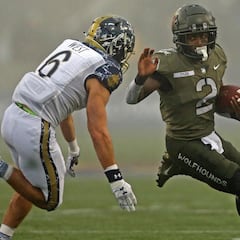What are the most common injuries in NFL?
Injuries in the NFL are such a central part of such a high impact game that we thought that it might be time to take a deep dive into the most common ones


Jameis Winston is out for the season with a torn ACL. Russell Wilson missed nearly half the season with a broken finger. Derrick Henry will not return this year after breaking his foot. It is the big injuries that catch our eye. Who can forget Joe Theismann’s horrific leg break, or Chucky Mullins’ neck-breaking tackle that left him paralysed? Almost forty years later and the images still cause those of us who witnessed these to shudder.
May 6, 1991
— Ole Miss Football (@OleMissFB) May 6, 2020
29 years ago today, Chucky Mullins left this world far too soon. We will never forget Chucky and his contagious positivity.
#38 #NeverQuit pic.twitter.com/9ZxCBLdZPM
Football is an dangerous sport. Injury is part of the game. Never has anyone suited up and gone into the fray only to finish the season unscathed. Perhaps a game, but never a whole season. And for those who play for years, making this not so much a game as a way of life, dealing with injury is part and parcel of that choice.
From the outset, the NFL has shown themselves willing, or even eager, to fundamentally alter the games rules in a seemingly never-ending quest for player safety. As early as 1894, use of the flying wedge was banned in regular play, although still used as a kickoff ruse until 2009 when all wedge formations were outlawed.
Yale football team in flying wedge formation, 1894.. Yale athletics, Yale University
Posted by Connecticut Explored on Wednesday, July 11, 2018
Three-time Super Bowl winner and Hall of Fame quarterback Troy Aikman has courted controversy by suggesting that the NFL should ditch helmets all together. His comments have drawn fire, but the suggestion isn’t as insane as it might first appear. After all, rugby is played worldwide with no pads of any kind, and the severity of injury in that sport is a fraction of what it is in the NFL. The most dangerous invention in the world of boxing was the addition of padded gloves. The argument is that by making players feel invulnerable, the use of pads and helmets encourage recklessness. Nobody goes flying in at full speed when they are not wearing body armor.
On average, six players per year will die while playing football, making three times safer than tennis or soccer. But in those sports, these deaths are almost entirely attributed to one thing alone. Heart conditions. Generally, a congenital or previously undiagnosed heart will give way under the strain carried by the constant running. In football, the deaths tend to be impact driven and far more dramatic. The rarity of these events though, would suggest that fear should not prevent anyone from competing in the game.
If you practice sports medicine, and it is indeed a fascinating field of study, then no sport offers the vast array of injury types as does the NFL. In baseball, the arm is the main focus of injury. In tennis, the joints hold that honor. But in football, the injuries can involve every system of the body, from cardiovascular to musculoskeletal to neurological.
I am Angelica Izuogu. I will become one of the few women physicians of an NFL team and other men’s professional sports teams. I will use my role to create opportunities for youth in underrepresented communities interested in sports and medicine. And I am WEL prepared. #WEL2020 pic.twitter.com/pjXHD7sJex
— Angelica🌻 (@gelli_3x) March 19, 2020
The NFL Physicians Society reports the most common injuries as "concussions, blunt injuries to the chest such as cardiac contusions, pulmonary contusions, broken ribs, abdominal injuries, splenic lacerations and kidney injuries." Orthopedic injuries to the knee, foot, ankle, shoulder, neck and back are also common, as are muscle strains to the hamstrings, quads, calves and the abdomen.
Of these injuries types, the most concerning in recent years has been the concussion. Research shows that repeated concussions may increase the risk that later in life mental health issues such as dementia, Parkinson's disease, and depression may occur. The NFL has instituted a raft of rule changes to outlaw helmet-to-helmet collisions and the targeting of the head area, particularly of players in a vulnerable position. Measures have also been enacted to better assess concussions on the sideline and to remove players from the game after they have been diagnosed with or suspected of having sustained a concussion.
Ever wonder what it looks like inside the blue medical tent on an NFL sideline? I got a chance to see, thanks to the NFL Physicians Society. #Jets pic.twitter.com/ibMH6S9Or7
— Rich Cimini (@RichCimini) October 21, 2019
In an effort to minimize the effects of gambling on the game, the NFL injury report was created and teams must now report the status of all of their players on a set schedule. The standard descriptions are:
- Out will not play in the upcoming game
- Doubtful 25% chance of playing
- Questionable 50% chance of playing
- Probable 75% chance of playing
In an effort to mislead opposing coaches, NFL teams have been known to downplay, exaggerate or obfuscate their injuries.
#Panthers Christian McCaffrey became the fastest #NFL player to reach 3K rushing yards and 3K receiving yards this season and now the disappointing news of his season-ending. #KeepPounding pic.twitter.com/u96BOUecxH
— NFL Rumors (@nflrums) November 29, 2021
Related stories
Since the 1970s, catastrophic, life-threatening injuries have been decreasing in football, thanks in large part to the rule changes and better medical diagnoses. However, in parallel to this trend, there has been an increase in major injury and shortened careers due mainly to the dramatically increased size and speed of players as well as the increased use of artificial turf.
In an effort to address the health issues in the post-football life of NFL player, the league has begun to take steps to create funds to cover the medical expenses that will be incurred, as well as compensating players effected. This of course, is too little too late for many players, but there is hope that finally the NFL and the Players Association may be on the road to finding a way forward. For all of the passion and enjoyment that these players have given us over the years, not to mention the heaps of money earned for the teams and league, we must ensure that they are looked after. It is the least that the NFL can do.
🏈 After a week that was full of movement in the pack, we take a look at the NFL Week 13 schedule with games, dates and times as well as how and where to watch. #nfl #nfltwitter https://t.co/4w4xY6svKu
— AS USA (@English_AS) December 1, 2021

